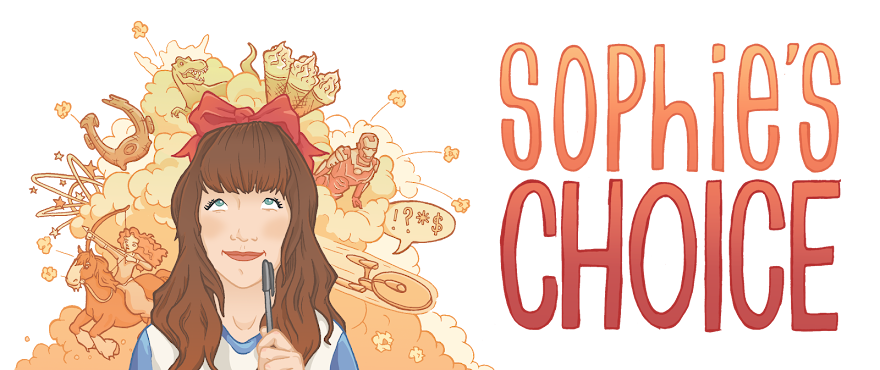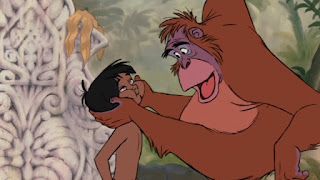The '50s went by in a flash, didn't they? Or maybe it was compared to Disney's painful offerings of the previous decade. In any case, the swinging '60s have lots of animated treats in store. After taking a one week break from dog-based tales with the traditional, dreamy
Sleeping Beauty, it's time to get our tails wagging again as we bound to London for...
One Hundred And One Dalmatians (1961)
The opposite of the balletic fairytale, Disney makes a confident departure to the modern age for their next feature. The opening credits set the tone – rather than a storybook opened to an angelic choir, we are greeted with whimsical spots and doodles, set against an upbeat jazzy score. Like with
Lady and the Tramp, concept art shows us the world and characters we are about to meet, purposely drawing us to the sketchy artistry of this doggy adventure.
 |
| Me trying to stay awake during a football match on TV |
However, unlike Disney's last canine story, where the humans are only seen from the waist-down with emphasis on the dog's suppliant world,
One Hundred And One Dalmatians is much more balanced between man and his dog. As well as equal framing for both humans and beasts, dogs control the narrative from the start.
Pongo the dalmatian's charming voice-over sets the scene, where he lives with his 'pet'
Roger, a musician, in an artistic London flat. His mission – to break Roger away from his bachelor's life by finding him a mate. Indeed, every dog seems to be an equal partner to their 'pet' human, with a parade of pooches who look exactly like their owners gracing the London streets.
 |
| Is this an acceptable lockdown activity, though? |
This fuels Roger and
Anita's 'meet-cute,' where Pongo literally runs rings around them to pull the eligible pair together. Of course, in the process he falls in love with Anita's dalmatian,
Perdita – cue some months later, and all four are married (yes, even the dogs) and are living happily under one roof. It all feels very rom-com, and I'm here for it.
Enter one of the best Disney villains of all time –
Cruella De Vil. Her reputation literally proceeds her as she casts a menacing silhouette at Roger and Anita's door. From her sweeping, smoke-filled entrance, her larger-than-life personality steals every scene she's in. The line-work of the animation works perfectly to bring to life this hard-edged fashionista.
 |
| I mean, she seems nice |
With an obviously evil name, maniacal cackle, and overtly nasty digs at Roger, you have got to wonder why Anita was ever friends with her in the first place. But hey, Cruella's dry comments are pretty funny, and you can't say she isn't a good antagonist. Probably one of the most purely horrible of all in fact, when you consider that her evil plans are literally just inspired by getting a new coat. And let's not get started on her driving skills.
Something to admire in
One Hundred And One Dalmatians is the contrast between cruelty and love, which inspires some surprisingly emotional moments. Yes, Cruella is horrendous, but she inspires a really sweet moment between Anita and Roger, where Roger writes her
eponymous theme tune and serenades his wife with it between fits of giggles. While Perdita is terrified for the fate of her puppies if Cruella gets her hands on them, Pongo is comforting, supportive, and full of love and concern when the litter arrives. Basically, he's a damn gent.
 |
| He's literally bringing a puppy back to life MY HEART!! |
Despite their best efforts though, Cruella's hapless henchman
Jasper and Horace manage to pinch the puppies, and Pongo and Perdita soon have to take the matters into their own paws. Introducing the iconic 'twilight bark.' That's right, I bet you didn't know that every dog across the country is part of a barking chain, so they can help a brother out. Well, it's true.
The second half of the film is basically an epic rescue mission, powered by a huge network of animals that provide Pongo and Perdita with information, shelter, and food to get their puppies – and the 84 others who are held captive at
Hell Hall (yes, it's literally called that) – home to safety.
 |
| Someone get this pup a gilet at least |
Getting all of the puppies out of the mansion in one piece is one thing, but their journey is filled with peril at every corner. Nearly dying from cold after trudging through the snow, they then almost get caught by Cruella's prowling car, which actually has your heart in your throat. I've never been happier to see someone drive off a cliff in my life.
All in all,
One Hundred And One Dalmatians is a refreshing departure from Disney's traditional fairytales and effectively launches the studio into the '60s. While it plays with a more expressive art style and modern humour, it doesn't lose any heart. You root for the protagonists all the way – of course it helps that most of them are adorable puppies.
 |
| Are these the most well-behaved dogs in the world? Probably. |
Best Song: 'Cruella De Vil,' which has become a classic in the Disney songbook, for its catchy tune and perfect villainous lyrics.
Disney Detail: There are two notable Disney Easter Eggs in this movie which I particularly enjoyed:
- The TV show that Jasper, Horace, and the puppies are watching when Tibbs finds them is the 1929 Walt Disney Silly Symphonies cartoon Springtime
- Most of the dogs from Lady and the Tramp make an appearance during the 'twilight bark' sequence – Jock, Peg, Lady, and Tramp can all be spotted in and around London (we have no idea how they got there though, or how they lived that long!)
Why it's a Classic: Apart from spawning a successful
live-action film (who can forget Glenn Close's maniacal Cruella?) and a
popular animated series,
One Hundred And One Dalmatians' unique art style makes it a go-to Disney film for merch, with the spotty dogs ironically becoming a fashion must-have.


















































